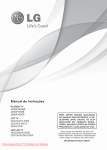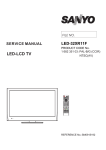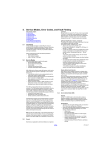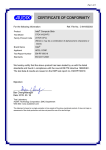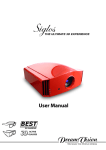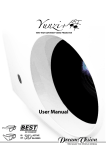Download LED LCD TV SERVICE MANUAL
Transcript
Internal Use Only North/Latin America Europe/Africa Asia/Oceania http://aic.lgservice.com http://eic.lgservice.com http://biz.lgservice.com LED LCD TV SERVICE MANUAL CHASSIS : LT01U MODEL : 42LV4500 42LV4500-DA CAUTION BEFORE SERVICING THE CHASSIS, READ THE SAFETY PRECAUTIONS IN THIS MANUAL. P/NO : MFL67011605 (1105-REV00) Printed in Korea CONTENTS CONTENTS .............................................................................................. 2 PRODUCT SAFETY ..................................................................................3 SPECIFICATION ........................................................................................6 ADJUSTMENT INSTRUCTION ...............................................................16 EXPLODED VIEW .................................................................................. 21 SVC. SHEET ............................................................................................... Copyright LG Electronics. Inc. All right reserved. Only for training and service purposes -2- LGE Internal Use Only SAFETY PRECAUTIONS IMPORTANT SAFETY NOTICE Many electrical and mechanical parts in this chassis have special safety-related characteristics. These parts are identified by in the Schematic Diagram and Exploded View. It is essential that these special safety parts should be replaced with the same components as recommended in this manual to prevent Shock, Fire, or other Hazards. Do not modify the original design without permission of manufacturer. Leakage Current Hot Check (See below Figure) Plug the AC cord directly into the AC outlet. General Guidance An isolation Transformer should always be used during the servicing of a receiver whose chassis is not isolated from the AC power line. Use a transformer of adequate power rating as this protects the technician from accidents resulting in personal injury from electrical shocks. It will also protect the receiver and it's components from being damaged by accidental shorts of the circuitry that may be inadvertently introduced during the service operation. If any fuse (or Fusible Resistor) in this TV receiver is blown, replace it with the specified. When replacing a high wattage resistor (Oxide Metal Film Resistor, over 1W), keep the resistor 10mm away from PCB. Do not use a line Isolation Transformer during this check. Connect 1.5K/10watt resistor in parallel with a 0.15uF capacitor between a known good earth ground (Water Pipe, Conduit, etc.) and the exposed metallic parts. Measure the AC voltage across the resistor using AC voltmeter with 1000 ohms/volt or more sensitivity. Reverse plug the AC cord into the AC outlet and repeat AC voltage measurements for each exposed metallic part. Any voltage measured must not exceed 0.75 volt RMS which is corresponds to 0.5mA. In case any measurement is out of the limits specified, there is possibility of shock hazard and the set must be checked and repaired before it is returned to the customer. Leakage Current Hot Check circuit Keep wires away from high voltage or high temperature parts. AC Volt-meter Before returning the receiver to the customer, always perform an AC leakage current check on the exposed metallic parts of the cabinet, such as antennas, terminals, etc., to be sure the set is safe to operate without damage of electrical shock. Leakage Current Cold Check(Antenna Cold Check) With the instrument AC plug removed from AC source, connect an electrical jumper across the two AC plug prongs. Place the AC switch in the on position, connect one lead of ohm-meter to the AC plug prongs tied together and touch other ohm-meter lead in turn to each exposed metallic parts such as antenna terminals, phone jacks, etc. If the exposed metallic part has a return path to the chassis, the measured resistance should be between 1MΩ and 5.2MΩ. When the exposed metal has no return path to the chassis the reading must be infinite. An other abnormality exists that must be corrected before the receiver is returned to the customer. Copyright LG Electronics. Inc. All right reserved. Only for training and service purposes -3- To Instrument’s exposed METALLIC PARTS 0.15uF Good Earth Ground such as WATER PIPE, CONDUIT etc. 1.5 Kohm/10W When 25A is impressed between Earth and 2nd Ground for 1 second, Resistance must be less than 0.1 Ω *Base on Adjustment standard LGE Internal Use Only SERVICING PRECAUTIONS CAUTION: Before servicing receivers covered by this service manual and its supplements and addenda, read and follow the SAFETY PRECAUTIONS on page 3 of this publication. NOTE: If unforeseen circumstances create conflict between the following servicing precautions and any of the safety precautions on page 3 of this publication, always follow the safety precautions. Remember: Safety First. General Servicing Precautions 1. Always unplug the receiver AC power cord from the AC power source before; a. Removing or reinstalling any component, circuit board module or any other receiver assembly. b. Disconnecting or reconnecting any receiver electrical plug or other electrical connection. c. Connecting a test substitute in parallel with an electrolytic capacitor in the receiver. CAUTION: A wrong part substitution or incorrect polarity installation of electrolytic capacitors may result in an explosion hazard. 2. Test high voltage only by measuring it with an appropriate high voltage meter or other voltage measuring device (DVM, FETVOM, etc) equipped with a suitable high voltage probe. Do not test high voltage by "drawing an arc". 3. Do not spray chemicals on or near this receiver or any of its assemblies. 4. Unless specified otherwise in this service manual, clean electrical contacts only by applying the following mixture to the contacts with a pipe cleaner, cotton-tipped stick or comparable non-abrasive applicator; 10% (by volume) Acetone and 90% (by volume) isopropyl alcohol (90%-99% strength) CAUTION: This is a flammable mixture. Unless specified otherwise in this service manual, lubrication of contacts in not required. 5. Do not defeat any plug/socket B+ voltage interlocks with which receivers covered by this service manual might be equipped. 6. Do not apply AC power to this instrument and/or any of its electrical assemblies unless all solid-state device heat sinks are correctly installed. 7. Always connect the test receiver ground lead to the receiver chassis ground before connecting the test receiver positive lead. Always remove the test receiver ground lead last. 8. Use with this receiver only the test fixtures specified in this service manual. CAUTION: Do not connect the test fixture ground strap to any heat sink in this receiver. Electrostatically Sensitive (ES) Devices Some semiconductor (solid-state) devices can be damaged easily by static electricity. Such components commonly are called Electrostatically Sensitive (ES) Devices. Examples of typical ES devices are integrated circuits and some field-effect transistors and semiconductor "chip" components. The following techniques should be used to help reduce the incidence of component damage caused by static by static electricity. 1. Immediately before handling any semiconductor component or semiconductor-equipped assembly, drain off any electrostatic charge on your body by touching a known earth ground. Alternatively, obtain and wear a commercially available discharging wrist strap device, which should be removed to prevent potential shock reasons prior to applying power to the Copyright LG Electronics. Inc. All right reserved. Only for training and service purposes unit under test. 2. After removing an electrical assembly equipped with ES devices, place the assembly on a conductive surface such as aluminum foil, to prevent electrostatic charge buildup or exposure of the assembly. 3. Use only a grounded-tip soldering iron to solder or unsolder ES devices. 4. Use only an anti-static type solder removal device. Some solder removal devices not classified as "anti-static" can generate electrical charges sufficient to damage ES devices. 5. Do not use freon-propelled chemicals. These can generate electrical charges sufficient to damage ES devices. 6. Do not remove a replacement ES device from its protective package until immediately before you are ready to install it. (Most replacement ES devices are packaged with leads electrically shorted together by conductive foam, aluminum foil or comparable conductive material). 7. Immediately before removing the protective material from the leads of a replacement ES device, touch the protective material to the chassis or circuit assembly into which the device will be installed. CAUTION: Be sure no power is applied to the chassis or circuit, and observe all other safety precautions. 8. Minimize bodily motions when handling unpackaged replacement ES devices. (Otherwise harmless motion such as the brushing together of your clothes fabric or the lifting of your foot from a carpeted floor can generate static electricity sufficient to damage an ES device.) General Soldering Guidelines 1. Use a grounded-tip, low-wattage soldering iron and appropriate tip size and shape that will maintain tip temperature within the range or 500°F to 600°F. 2. Use an appropriate gauge of RMA resin-core solder composed of 60 parts tin/40 parts lead. 3. Keep the soldering iron tip clean and well tinned. 4. Thoroughly clean the surfaces to be soldered. Use a mall wirebristle (0.5 inch, or 1.25cm) brush with a metal handle. Do not use freon-propelled spray-on cleaners. 5. Use the following unsoldering technique a. Allow the soldering iron tip to reach normal temperature. (500°F to 600°F) b. Heat the component lead until the solder melts. c. Quickly draw the melted solder with an anti-static, suctiontype solder removal device or with solder braid. CAUTION: Work quickly to avoid overheating the circuit board printed foil. 6. Use the following soldering technique. a. Allow the soldering iron tip to reach a normal temperature (500°F to 600°F) b. First, hold the soldering iron tip and solder the strand against the component lead until the solder melts. c. Quickly move the soldering iron tip to the junction of the component lead and the printed circuit foil, and hold it there only until the solder flows onto and around both the component lead and the foil. CAUTION: Work quickly to avoid overheating the circuit board printed foil. d. Closely inspect the solder area and remove any excess or splashed solder with a small wire-bristle brush. -4- LGE Internal Use Only IC Remove/Replacement Some chassis circuit boards have slotted holes (oblong) through which the IC leads are inserted and then bent flat against the circuit foil. When holes are the slotted type, the following technique should be used to remove and replace the IC. When working with boards using the familiar round hole, use the standard technique as outlined in paragraphs 5 and 6 above. Removal 1. Desolder and straighten each IC lead in one operation by gently prying up on the lead with the soldering iron tip as the solder melts. 2. Draw away the melted solder with an anti-static suction-type solder removal device (or with solder braid) before removing the IC. Replacement 1. Carefully insert the replacement IC in the circuit board. 2. Carefully bend each IC lead against the circuit foil pad and solder it. 3. Clean the soldered areas with a small wire-bristle brush. (It is not necessary to reapply acrylic coating to the areas). "Small-Signal" Discrete Transistor Removal/Replacement 1. Remove the defective transistor by clipping its leads as close as possible to the component body. 2. Bend into a "U" shape the end of each of three leads remaining on the circuit board. 3. Bend into a "U" shape the replacement transistor leads. 4. Connect the replacement transistor leads to the corresponding leads extending from the circuit board and crimp the "U" with long nose pliers to insure metal to metal contact then solder each connection. Power Output, Transistor Device Removal/Replacement 1. Heat and remove all solder from around the transistor leads. 2. Remove the heat sink mounting screw (if so equipped). 3. Carefully remove the transistor from the heat sink of the circuit board. 4. Insert new transistor in the circuit board. 5. Solder each transistor lead, and clip off excess lead. 6. Replace heat sink. Circuit Board Foil Repair Excessive heat applied to the copper foil of any printed circuit board will weaken the adhesive that bonds the foil to the circuit board causing the foil to separate from or "lift-off" the board. The following guidelines and procedures should be followed whenever this condition is encountered. At IC Connections To repair a defective copper pattern at IC connections use the following procedure to install a jumper wire on the copper pattern side of the circuit board. (Use this technique only on IC connections). 1. Carefully remove the damaged copper pattern with a sharp knife. (Remove only as much copper as absolutely necessary). 2. carefully scratch away the solder resist and acrylic coating (if used) from the end of the remaining copper pattern. 3. Bend a small "U" in one end of a small gauge jumper wire and carefully crimp it around the IC pin. Solder the IC connection. 4. Route the jumper wire along the path of the out-away copper pattern and let it overlap the previously scraped end of the good copper pattern. Solder the overlapped area and clip off any excess jumper wire. At Other Connections Use the following technique to repair the defective copper pattern at connections other than IC Pins. This technique involves the installation of a jumper wire on the component side of the circuit board. 1. Remove the defective copper pattern with a sharp knife. Remove at least 1/4 inch of copper, to ensure that a hazardous condition will not exist if the jumper wire opens. 2. Trace along the copper pattern from both sides of the pattern break and locate the nearest component that is directly connected to the affected copper pattern. 3. Connect insulated 20-gauge jumper wire from the lead of the nearest component on one side of the pattern break to the lead of the nearest component on the other side. Carefully crimp and solder the connections. CAUTION: Be sure the insulated jumper wire is dressed so the it does not touch components or sharp edges. Diode Removal/Replacement 1. Remove defective diode by clipping its leads as close as possible to diode body. 2. Bend the two remaining leads perpendicular y to the circuit board. 3. Observing diode polarity, wrap each lead of the new diode around the corresponding lead on the circuit board. 4. Securely crimp each connection and solder it. 5. Inspect (on the circuit board copper side) the solder joints of the two "original" leads. If they are not shiny, reheat them and if necessary, apply additional solder. Fuse and Conventional Resistor Removal/Replacement 1. Clip each fuse or resistor lead at top of the circuit board hollow stake. 2. Securely crimp the leads of replacement component around notch at stake top. 3. Solder the connections. CAUTION: Maintain original spacing between the replaced component and adjacent components and the circuit board to prevent excessive component temperatures. Copyright LG Electronics. Inc. All right reserved. Only for training and service purposes -5- LGE Internal Use Only SPECIFICATION NOTE : Specifications and others are subject to change without notice for improvement. 1. Application range 3. Test method This specification is applied to LCD TV used LT01U chassis. 1) Performance: LGE TV test method followed 2) Demanded other specification - Safety: CE / IEC / BSMI specification EMI: CE / IEC / BSMI 2. Requirement for Test Each part is tested as below without special appointment. 1) Temperature : 25 ºC ± 5 ºC (77 ºF ± 9 ºF), CST : 40ºC ± 5 ºC 2) Relative Humidity : 65 ± 10 % 3) Power Voltage : Standard input voltage (100-240V~50/60Hz) * Standard Voltage of each products is marked by models. 4) Specification and performance of each parts are followed each drawing and specification by part number in accordance with BOM. 5) The receiver must be operated for about 20 minutes prior to the adjustment. Copyright LG Electronics. Inc. All right reserved. Only for training and service purposes -6- LGE Internal Use Only 4. Electrical specification 4.1. Module Specification No Item Specification Remark 1 Screen Device 32”/37”/42”/47”/55” wide Color Display module LCD 2 Aspect Ratio 16:9 3 LCD Module 31.55 inch T315HW04 V9(AUO) 31.51inch LC320EXN-SDA1(LGD) LC320EUN-SDV2(LGD) LC320WUN-SCA2(LGD) LC320WXN-SCA2(LGD) 37inch LC370WUE-SCA1(LGD) KC370EUN-SDV2(LGD) 42inch LC420WUE-SCA2(LGD) V420H2-LE5(CMI) LC420EUF-SDA1(LGD) LC420EUF-SDF1(LGD) LC420EUN-SDV3(LGD) 47inch LC470WUF-SCA2(LGD) LC470EUF-SDA1(LGD) LC470EUF-SDF1(LGD) 55inch LC550EUF-SDA1(LGD) 4 Operating Environment 1) Temp. : 0 ~ 40 deg 5 Storage Environment 6 Input Voltage AC100-240V~, 50/60Hz 7 Power Consumption 40.78W 32” HD LC320EXN-SDA1(LGD) 105W 32” FHD T315HW04 V9(AUO) 61W 32” FHD T315HW07-V8(AUO FHD LED) 148W 37” FHD LC370WUE-SCA1(LGD) 176W 42” FHD LC420WUE-SCA2(LGD) 125W 42” FHD V420H2-LE5(CMI) 233W 47” FHD LC470WUF-SCA2(LGD) 2) Humidity : 0 ~ 80% 1) Temp.: -20 ~ 60 deg 2) Humidity : 0 ~ 85 % 8 Module Size 128.3W 55” FHD LC550EUF-SDA1(LGD) LGD 32” 735.4 (H) x 433.0 (V) x 10.8 (D) LC320EXN-SDA1(LGD) AUO 32” 760.0 (H) x 450.0 (V) x 46.9 (D) T315HW04 V9(AUO) LGD 37” 877.0 (H) x 516.8 (V) x 36.4 (D) LC370WUE-SCA1(LGD) LGD 42” 983.0 (H) x 576.0 (V) x 46.0 (D) LC420WUE-SCA2(LGD) CMI 42” 968.4 (H) x 564 (V) x 10.8 (D) V420H2-LE5(CMI) LGD 47” 1096.0(H) x 640.0(V) x 35.5 (D) LC470WUF-SCA2(LGD) Copyright LG Electronics. Inc. All right reserved. Only for training and service purposes -7- LGE Internal Use Only 5. Chroma& Brightness 5.1. Module optical specification 5.1.1. 32” TFT-LCD Module (AUO) – T315HW04 V9 No. 1. Item Viewing Angle<CR>10> 2. Luminance 3. Contrast Ratio Specification Min. Right/Left/Up/Down 89 Luminance (cd/m2) 320 400 3200 4000 Variation 4. WX Max. 1.3 All white/ All black 0.28 WY Typ 0.29 Typ RED Xr - 0.03 0.64 +0.03 Yr 0.33 Green Xg 0.29 CIE Color Coordinates Blue Remark CR > 10 - CR White Typ. Yg 0.60 Xb 0.15 Yb 0.06 PSM: Vivid, CSM: Cool White (85IRE) 1) Optical characteristics are determined after the unit has been ‘ON’ and stable in a dark environment at 25±2°C 2) Surface luminance is the luminance value at center 1-point across the LCD surface 50cm from the surface with all pixels displaying white. 5.1.2. 32” TFT-LCD Module (CMI) – V315B5-LE3 No. 1. Item Viewing Angle<CR>10> 2. Luminance 3. Contrast Ratio Specification Min. Right/Left/Up/Down 88 Luminance (cd/m2) 360 450 3750 5000 WY Typ 0.290 Typ Xr - 0.03 0.648 +0.03 Variation RED 4. CIE Color Coordinates WX Max. Remark CR > 10 - CR White Typ. 1.3 All white/ All black 0.280 Yr 0.321 Green Xg 0.304 Yg 0.617 Blue Xb 0.149 Yb 0.063 PSM: Vivid, CSM: Cool White (85IRE) 1) Optical characteristics are determined after the unit has been ‘ON’ and stable in a dark environment at 25±2°C 2) Surface luminance is the luminance value at center 1-point across the LCD surface 50cm from the surface with all pixels displaying white. Copyright LG Electronics. Inc. All right reserved. Only for training and service purposes -8- LGE Internal Use Only 5.1.3. 32” TFT-LCD Module (CMI) – V315H3-LE7 No. 1. Item Viewing Angle<CR>10> 2. Luminance 3. Contrast Ratio Specification Min. Right/Left/Up/Down 88 Luminance (cd/m2) 360 450 3500 5000 WY Typ 0.290 Typ Xr - 0.03 0.635 +0.03 Variation RED 4. CIE Color Coordinates WX Max. Remark CR > 10 - CR White Typ. 1.3 All white/ All black 0.280 Yr 0.323 Green Xg 0.288 Yg 0.600 Blue Xb 0.148 Yb 0.050 PSM: Vivid, CSM: Cool White (85IRE) 1) Optical characteristics are determined after the unit has been ‘ON’ and stable in a dark environment at 25±2°C 2) Surface luminance is the luminance value at center 1-point across the LCD surface 50cm from the surface with all pixels displaying white. 5.1.4. 32” TFT-LCD Module (IPS) – VVX32H109G00 No. 1. Item Viewing Angle<CR>10> Specification Min. Right/Left/Up/Down 88 Typ. Max. Remark CR > 10 Luminance (cd/m2) 2. Luminance 3. Contrast Ratio Variation White RED 4. - CR CIE Color Coordinates 1.3 700 1200 WY Typ 0.285 Typ Xr - 0.03 0.645 +0.03 WX All white/ All black 0.278 Yr 0.330 Green Xg 0.300 Yg 0.620 Blue Xb 0.153 Yb 0.065 PSM: Vivid, CSM: Cool White (85IRE) 1) Optical characteristics are determined after the unit has been ‘ON’ and stable in a dark environment at 25±2°C 2) Surface luminance is the luminance value at center 1-point across the LCD surface 50cm from the surface with all pixels displaying white. Copyright LG Electronics. Inc. All right reserved. Only for training and service purposes -9- LGE Internal Use Only 5.1.5. 37” TFT-LCD Module (LGD) – LC37WUE-SCA1 No. 1. Item Viewing Angle<CR>10> 2. Luminance 3. Contrast Ratio Specification Min. Right/Left/Up/Down 89 Luminance (cd/m2) 400 500 1100 1500 WY Typ 0.292 Typ Xr - 0.03 0.634 +0.03 Variation RED 4. CIE Color Coordinates WX Max. Remark CR > 10 - CR White Typ. 1.3 All white/ All black 0.279 Yr 0.334 Green Xg 0.289 Yg 0.606 Blue Xb 0.145 Yb 0.065 PSM: Vivid, CSM: Cool White (85IRE) 1) Optical characteristics are determined after the unit has been ‘ON’ and stable in a dark environment at 25±2°C 2) Surface luminance is the luminance value at center 1-point across the LCD surface 50cm from the surface with all pixels displaying white. 5.1.6. 37” TFT-LCD Module (AUO) – T370HW05-V1 No. 1. 2. Item Viewing Angle<CR>10> Specification Min. Right/Left/Up/Down 89 Luminance (cd/m2) 320 Contrast Ratio Remark CR > 10 400 - CR White 4. Max. Luminance Variation 3. Typ. 3200 WX 1.3 4000 All white/ All black 0.280 WY Typ 0.290 Typ RED Xr - 0.03 0.640 +0.03 Yr 0.330 Green Xg 0.320 Yg 0.620 Blue Xb 0.150 Yb 0.050 CIE Color Coordinates PSM: Vivid, CSM: Cool White (85IRE) 1) Optical characteristics are determined after the unit has been ‘ON’ and stable in a dark environment at 25±2°C 2) Surface luminance is the luminance value at center 1-point across the LCD surface 50cm from the surface with all pixels displaying white. Copyright LG Electronics. Inc. All right reserved. Only for training and service purposes - 10 - LGE Internal Use Only 5.1.7. 42” LCD Module (LGD) – LC420WUE-SCA2 No. 1. Item Viewing Angle<CR>10> 2. Luminance 3. Contrast Ratio Specification Min. Right/Left/Up/Down 89 Luminance (cd/m2) 400 500 1100 1500 WY Typ 0.292 Typ Xr - 0.03 0.636 +0.03 Variation RED 4. CIE Color Coordinates WX Max. Remark CR > 10 - CR White Typ. 1.3 All white/ All black 0.279 Yr 0.335 Green Xg 0.291 Yg 0.603 Blue Xb 0.146 Yb 0.061 PSM: Vivid, CSM: Cool White (85IRE) 1) Optical characteristics are determined after the unit has been ‘ON’ and stable in a dark environment at 25±2°C 2) Surface luminance is the luminance value at center 1-point across the LCD surface 50cm from the surface with all pixels displaying white. 5.1.8. 42” TFT-LCD Module (CMO) – V420H2-LE5 No. 1. Item Viewing Angle<CR>10> Specification Min. Typ. Right/Left/Up/Down 80 80 Luminance (cd/m ) 300 400 4200 6000 WY Typ 0.290 Typ Xr - 0.03 0.644 +0.03 2 2. Luminance 3. Contrast Ratio Variation White RED 4. - CR CIE Color Coordinates Green Blue WX Max. Remark CR > 10 1.3 All white/ All black 0.280 Yr 0.331 Xg 0.295 Yg 0.617 Xb 0.148 Yb 0.053 PSM: Vivid, CSM: Cool White (85IRE) 1) Optical characteristics are determined after the unit has been ‘ON’ and stable in a dark environment at 25±2°C 2) Surface luminance is the luminance value at center 1-point across the LCD surface 50cm from the surface with all pixels displaying white. Copyright LG Electronics. Inc. All right reserved. Only for training and service purposes - 11 - LGE Internal Use Only 5.1.9. 42” TFT-LCD Module (AUO) – T420HW08-V1 No. 1. Item Viewing Angle<CR>10> Specification Min. Right/Left/Up/Down 89 Luminance (cd/m2) 2. Luminance 3. Contrast Ratio CIE Color Coordinates Remark CR > 10 - CR RED 4. Max. 400 Variation White Typ. 1.3 4200 6000 WY Typ 0.290 Typ Xr - 0.03 0.640 +0.03 WX All white/ All black 0.280 Yr 0.330 Green Xg 0.281 Yg 0.590 Blue Xb 0.144 Yb 0.060 PSM: Vivid, CSM: Cool White (85IRE) 1) Optical characteristics are determined after the unit has been ‘ON’ and stable in a dark environment at 25±2°C 2) Surface luminance is the luminance value at center 1-point across the LCD surface 50cm from the surface with all pixels displaying white. 5.1.10. 47” LCD Module (LGD) – LC470WUF-SCA2 No. 1. Item Viewing Angle<CR>10> 2. Luminance 3. Contrast Ratio Specification Min. Right/Left/Up/Down 89 Luminance (cd/m2) 400 500 1100 1450 Variation 4. WX Max. 1.3 All white/ All black 0.279 WY Typ 0.292 Typ RED Xr - 0.03 0.639 +0.03 Yr 0.334 Green Xg 0.290 Yg 0.606 Blue Xb 0.146 Yb 0.058 CIE Color Coordinates Remark CR > 10 - CR White Typ. PSM: Vivid, CSM: Cool White (85IRE) 1) Optical characteristics are determined after the unit has been ‘ON’ and stable in a dark environment at 25±2°C 2) Surface luminance is the luminance value at center 1-point across the LCD surface 50cm from the surface with all pixels displaying white. Copyright LG Electronics. Inc. All right reserved. Only for training and service purposes - 12 - LGE Internal Use Only 5.1.11. 55” LCD Module (LGD) – LC550EUF-SDA1 No. 1. Item Viewing Angle<CR>10> 2. Luminance 3. Contrast Ratio Specification Min. Right/Left/Up/Down 89 Luminance (cd/m2) 360 450 1100 1600 WY Typ 0.292 Typ Xr - 0.03 0.649 +0.03 Variation RED 4. CIE Color Coordinates Max. WX Remark CR > 10 - CR White Typ. 1.3 All white/ All black 0.279 Yr 0.332 Green Xg 0.307 Yg 0.595 Blue Xb 0.149 Yb 0.059 PSM: Vivid, CSM: Cool White (85IRE) 1) Optical characteristics are determined after the unit has been ‘ON’ and stable in a dark environment at 25±2°C 2) Surface luminance is the luminance value at center 1-point across the LCD surface 50cm from the surface with all pixels displaying white. 5.2. Chroma (PSM:Vivid, Color Temperature:Cool) - except “RGB PC Mode PSM: Standard, Color Temperature:Medium” ** The W/B Tolerance is ±0.002 for Adjustment, but for DQA ±0.015 No. 1. 2. 3. Item Cool Medium Warm Min Typ Max Remark White Balance,X axis 0.267 0.269 0.271 PSM: Vivid, CSM: Cool, White Balance,Y axis 0.271 0.273 0.275 White (85IRE) White Balance,X axis 0.283 0.285 0.287 Color Temp : C50 -> Cool White Balance,Y axis 0.291 0.293 0.295 0 White Balance,X axis 0.311 0.313 0.315 W50 -> Warm White Balance,Y axis 0.327 0.329 0.331 Copyright LG Electronics. Inc. All right reserved. Only for training and service purposes - 13 - -> Medium LGE Internal Use Only 6. Component Video Input (Y, CB/PB, CR/PR) Specification No Resolution Remark H-freq(kHz) V-freq(Hz) 1. 720x480 15.73 60.00 SDTV,DVD 480i 2. 720x480 15.63 59.94 SDTV,DVD 480i 3. 720x480 31.47 59.94 480p 4. 720x480 31.50 60.00 480p 5. 720x576 15.625 50.00 SDTV,DVD 625 Line 6. 720x576 31.25 50.00 HDTV 576p 7. 1280x720 37.50 50.00 HDTV 720p 8. 1280x720 44.96 59.94 HDTV 720p 9. 1280x720 45.00 60.00 HDTV 720p 10. 1920x1080 28.125 50.00 HDTV 1080i 11. 1920x1080 33.75 60.00 HDTV 1080i 12. 1920x1080 33.72 59.94 HDTV 1080i 13. 1920x1080 56.250 50 HDTV 1080p 14. 1920x1080 67.43/67.5 59.94/60 HDTV 1080p 7. RGB (PC) Specification No Resolution 1. 720*400 Proposed H-freq(kHz) V-freq(Hz) Pixel Clock(MHz) 31.468 70.08 28.321 For only DOS mode 2. 640*480 31.469 59.94 25.17 VESA 3. 800*600 37.879 60.31 40.00 VESA 4. 1024*768 48.363 60.00 65.00 VESA(XGA) 5. 1280*768 47.78 59.87 79.5 WXGA 6. 1360*768 47.72 59.8 84.75 WXGA 7. 1920*1080 66.587 59.93 138.625 WUXGA Copyright LG Electronics. Inc. All right reserved. Only for training and service purposes - 14 - Remark Input 848*480 60Hz, 852*480 60Hz -> 640*480 60Hz Display FHD model LGE Internal Use Only 8. HDMI Input (PC/DTV) 8.1. DTV Mode No Resolution H-freq(kHz) V-freq.(Hz) Pixel clock(MHz) Proposed 1. 720*480 31.469 /31.5 59.94 / 60 27.00/27.03 SDTV 480P 2. 720*576 31.25 50 54 SDTV 576P 3. 1280*720 37.500 50 74.25 HDTV 720P 4. 1280*720 44.96 / 45 59.94 / 60 74.17/ 74.25 HDTV 720P 5. 1920*1080 33.72 / 33.75 59.94 / 60 74.17/ 74.25 HDTV 1080I 6. 1920*1080 28.125 50.00 74.25 HDTV 1080I 7. 1920*1080 26.97 / 27 23.97 / 24 74.17/ 74.25 HDTV 1080P 8. 1920*1080 33.716 / 33.75 29.976 / 30.00 74.25 HDTV 1080P 9. 1920*1080 56.250 50 148.5 HDTV 1080P 10. 1920*1080 67.43 / 67.5 59.94 / 60 148.35/148.50 HDTV 1080P Remark 8.2. PC Mode No Resolution H-freq(kHz) V-freq.(Hz) 70.08 Pixel clock(MHz) Proposed 28.321 Remark 1. 720*400 31.468 HDCP 2. 640*480 31.469 59.94 25.17 VESA HDCP 3. 800*600 37.879 60.31 40.00 VESA HDCP 4. 1024*768 48.363 60.00 65.00 VESA(XGA) HDCP 5. 1280*768 47.78 59.87 79.5 WXGA HDCP 6. 1360*768 47.72 59.8 84.75 WXGA HDCP 7. 1920*1080 67.5 60 148.5 WUXGA HDCP Copyright LG Electronics. Inc. All right reserved. Only for training and service purposes - 15 - LGE Internal Use Only ADJUSTMENT INSTRUCTION 1. Application Range This specification sheet is applied to all of the LCD TV with LT01T/U chassis. (4) filexxx.bin 2. Designation 1) The adjustment is according to the order which is designated and which must be followed, according to the plan which can be changed only on agreeing. 2) Power Adjustment: Free Voltage 3) Magnetic Field Condition: Nil. 4) Input signal Unit: Product Specification Standard 5) Reserve after operation: Above 5 Minutes (Heat Run) Temperature : at 25±5ºC Relative humidity : 65±10% Input voltage : 220V, 60Hz 6) Adjustment equipments: Color Analyzer (CA-210 or CA110), Pattern Generator(MSPG-925L or Equivalent), DDC Adjustment Jig equipment, SVC remote controller 7) Push The “IN STOP KEY” - For memory initialization. (4) Click “Connect” tab. If “Can’t” is displayed, check connection between computer, jig, and set. (1) (2) Case1 : Software version up 1. After downloading S/W by USB, TV set will reboot automatically 2. Push “In-stop” key 3. Push “Power on” key 4. Function inspection 5. After function inspection, Push “I n-stop” key. Case2 : Function check at the assembly line 1. When TV set is entering on the assembly line, Push “In-stop” key at first. 2. Push “Power on” key for turning it on. -> If you push “Power on” key, TV set will recover channel information by itself. 3. After function inspection, Push “In-stop” key. (3) OK Please Check the Speed : To use speed between from 200KHz to 400KHz (5) Click “Auto” tab and set as below (6) Click “Run”. (7) After downloading, check “OK” message. (5) filexxx.bin (6) (8) ……….OK 3. Main PCB check process (7) * APC - After Manual-Insert, executing APC * Boot file Download (1) Execute ISP program “Mstar ISP Utility” and then click “Config” tab. (2) Set as below, and then click “Auto Detect” and check “OK” message. If “Error” is displayed, Check connection between computer, jig, and set.. (3) Click “Read” tab, and then load download file (XXXX.bin) by clicking “Read”. Copyright LG Electronics. Inc. All right reserved. Only for training and service purposes - 16 - LGE Internal Use Only * USB DOWNLOAD(*.epk file download) Model (1) Put the USB Stick to the USB socket. (2) Automatically detecting update file in USB Stick. - If your downloaded program version in USB Stick is Low, it didn’t work. But your downloaded version is High, USB data is automatically detecting (3) Show the message “Copying files from memory” Tool option1 Tool option2 Tool option3 Tool option4 Tool option5 32LK330-DB_IPS 18000 18966 51204 26892 33 26LK330-DB_AUO 13896 18966 51204 26892 33 22LK330-DB_CMI 9796 18966 51204 26892
































































